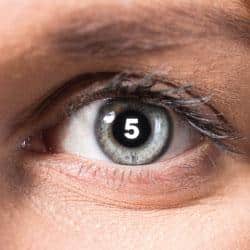
The cornea consists of a highly ordered group of cells and proteins with essential nerve endings. It is the transparent front part of the eye; covering the pupil, iris, and anterior eye chamber. Its transparency allows it to refract the right amount of light in the right direction; even a slight change in this consistency results in altered vision. If transparency lessens, blurred vision can result.
The following will help you understand five common conditions that impact the cornea and how you can identify and treat each one.
The human cornea has five layers in order, listed outermost to innermost:
5 Layers of The Cornea
- Corneal Epithelium – The cornea’s outermost region makes up approximately 10 percent of the tissue’s thickness.
- Bowman’s Layer – This sturdy layer of collagen protein fibers is beneath the membrane of the epithelium. If this layer is damaged, it can develop a scar when it heals. If the scar is towards the middle of the eye, it often causes some vision loss.
- Corneal Stroma –The stroma layer comprises 90 percent of the cornea’s tissue. The unique shape of this layer and lack of blood vessels produce the cornea’s transparency.
- Descemet’s Membrane – This layer is a thin piece of tissue. Its main function is to protect against injuries and infection. The Descemet’s membrane consists of collagen fibers.
- Corneal Endothelium – An extremely thin layer, this is the innermost layer of the cornea. These cells are necessary in order to keep the cornea transparent.
If any injury breaks through to a deeper layer of the cornea, the healing process takes longer and may result in the following symptoms: blurred vision, pain, redness, sensitivity to light and tearing. More serious injuries will produce corneal scarring, which can cause distorted vision or even dramatically impaired vision. If you experience any of these symptoms, please consult an eye care professional.
Given the importance of the cornea, Barnet Dulaney Perkins Eye Center has developed the following comprehensive list of five cornea conditions, their symptoms and how to treat them.
1. Allergies
Allergies affect almost everyone at some point in their life. Typically eye allergies are triggered by one of the following:
- Indoor allergens like dust, mold and dander
- Outdoor allergens like pollens
- Irritants like smoke and perfume
Symptoms: Itching, redness, burning, clear or watery discharge, mucus discharge, sensitivity to light, puffiness, hazy vision, and foreign body sensation. A foreign body sensation is when a person feels there is something in their eye even when there is not.
Treatment: Allergy symptoms are mostly temporary but can cause discomfort. Eliminating the irritant will cause allergy symptoms to stop. But for temporary relief, prescription or over the counter eye drops may help. Applying a cool compress to the eye will relieve itching and swelling. Systemic antihistamines such as Claritin have limited effect on ocular allergies.
Prevention: Avoiding the allergen if known.
2. Ocular Surface Disease / Dry Eye
One of the most common eye conditions that people experience is dry eye. For some, the condition is persistent and extremely painful.
Tears provide a crucial role in eye health. They wash away dirt and irritants while keeping the eye’s surface moist and clean. This prevents potential irritation, damage or even infections caused by injuries or bacteria.
Tears consist of three elements to protect the overall health of the eye:
- An oily layer – lipid
- A watery layer – aqueous
- A coating layer – mucin.
When the eye no longer produces enough tears or the quality of tears necessary to maintain eye health, everyday activities may become difficult and/or painful.
Common causes for dry eye include: allergies, contact lens use, skin disease around the eyelids, exposure to chemicals or tobacco smoke, and some medications. Age is also a factor as most people over the age of 65 have experienced dry eye.
Symptoms: Red eyes, redness of the eyelids, foreign body sensation, itching, eye discomfort, hazy vision, and burning or stinging in the eye.
Treatment: Depending on the cause, these can be varied.
- The treatments include warm compresses, over-the-counter eye drops, prescription eye drops, oral medications, punctual plugs (small bio-devices inserted into the tear ducts), or eyelid surgery.
- Intense pulsed light therapy (IPL) can help reduce symptoms of dry eyes by decreasing inflammation and increasing the health of the tear film. The treatment focuses on the lids which play a crucial part in maintaining the health of the ocular surface. IPL improves the lipid layer of the tear film thus decreasing evaporation and improving comfort.
- Lipiflow can also help by treating the lids with heat and massage. The lipid layer is improved resulting in improved comfort.
- Environmental modifications such as avoiding direct drafts and dry climates and blinking exercises may prevent some of the effects of dry eyes.
Prevention: Protect your eyes by using an air filter indoors, wear sunglasses that wrap around the sides, and use artificial tears regularly.
3. Infections
Eye infections can affect one or both eyes and any part of the eye. In order to maintain its transparency, the cornea, unlike most other tissues in the body, does not contain blood vessels. This puts the cornea at a particular disadvantage when it comes to fighting infections. Two common eye infections are conjunctivitis – also known as pink eye – and corneal ulcers. Viral infections of the cornea including herpes simplex (the cold sore virus) and herpes zoster (the virus responsible for shingles) can severely affect vision and comfort.
Symptoms: Redness, itching, swelling, discharge, pain, or distorted vision.
Treatment: Depends on the type of infection, but treatment typically includes eye drops, creams or antibiotics. Severe infections should be treated promptly to avoid significant damage to the eye and vision loss.
Prevention: Always wash your hands before touching your eyes and practice good hygiene.
4. Herpes Zoster (Shingles)
This condition is an infection caused by the common chickenpox virus or the varicella-zoster virus. Once someone contracts the virus, it remains inactive within the central nervous system and if reactivated, produces an agonizing blistering rash called shingles. Anyone exposed to the varicella-zoster virus can develop herpes zoster; however, there are two general risk factors: 1) advance age and 2) a weakened immune system.
An essential note about herpes zoster is that corneal damage can appear once the shingles have disappeared. It is important to schedule a follow-up appointment if you’ve experienced facial shingles to avoid any long-term effects.
Symptoms: High temperature, painful rash, eye redness, light sensitivity, blurry or foggy vision. Decreased corneal sensitivity can be caused by herpes zoster and is often permanent.
Treatment: An oral anti-viral treatment might lessen the risk of the virus infecting deep cells which could impair vision.
Herpes Simplex can affect the eye in a similar way although there does not need to be any associated rash before the onset of ocular symptoms.
Prevention: Practicing good hygiene by washing your hands before you touch your eyes, especially when wearing contact lenses, is important. While pink eye can be spread from person to person, herpes zoster and herpes simplex typically are not spread to the eye by a person to person transmission.
5. Corneal Dystrophies
There are more than 20 different types of corneal dystrophies – each one affecting different parts of the cornea. With corneal dystrophy, one or more pieces of the cornea’s regular clarity changes due to a shape change or an increase in cloudy-like material within the eye. A dystrophy is typically inherited and can affect both eyes equally. Usually dystrophies progress gradually.
Symptoms: Symptoms vary depending on the dystrophy. Some cause severe visual impairment, while others are discovered during regular checkups because they show little to no symptoms in the early stages. Still other dystrophies are periodic and cause pain from time to time but leave no permanent loss of vision.
Common dystrophies include:
- Fuch’s Dystrophy
- Keratoconus
- Lattice Dystrophy type I
- Lattice Dystrophy type II
- Map dot fingerprint dystrophy
Treatment: Depending on the dystrophy, and how severe the case, treatment will vary. If caught early enough and symptoms have not started, the doctor may monitor the condition to make sure the disorder does not progress. If you’re showing symptoms, the doctor may prescribe ointments, eye drops or laser treatment.
Repeat corneal erosion cases are treated with lubricating eye drops, antibiotics, ointments, or special protective contact lenses. If erosion persists, further treatment may consist of a laser therapy or a procedure for scraping the cornea. A cornea transplant may be needed in more extreme cases. Depending on the layer affected, the cornea transplant may replace the full thickness of the cornea or only one layer. Some cornea transplants can be done with the help of a laser.
Prevention: No prevention is known at this time. There is some research suggesting smoking is associated with more advanced Fuchs endothelial dystrophy.
Protecting Your Eyes from Injury
Since the cornea is the most exposed part of the eye, injuries to the cornea are relatively common. The cornea deals fairly well with minor injuries. Superficial scratches are oftentimes healed by cells of the surface sliding over and patching the defect. Deeper injuries can take longer to heal and require the care of an eye care professional. Deeper injuries can lead to scarring and can affect your vision more than superficial ones.
Symptoms: Symptoms vary depending on the injury. Light sensitivity, redness and tearing are common symptoms.
Treatment: Depending on the injury and the severity, treatment may consist of observation with pain control and possibly a bandage contact lenses. More severe injuries may require surgery.
Prevention: Eye protection is a crucial part in preventing eye injuries.
It’s important to stay vigilant about your eye care to prevent irreversible damage. Barnet Dulaney Perkins Eye Center offers regular eye health exams and expert advice to keep your eyes working at their best.


